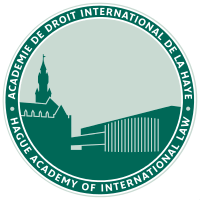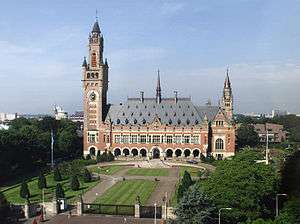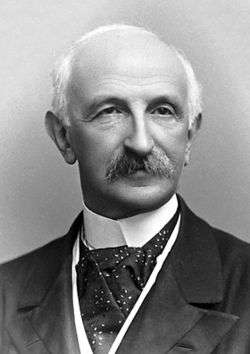The Hague Academy of International Law
| Académie de droit international de La Haye | |
 | |
| Established | 1923 |
|---|---|
| Location | Peace Palace, The Hague, Netherlands |
| Website | hagueacademy.nl |

The Hague Academy of International Law (French: Académie de droit international de La Haye) is a center for high-level education in both public and private international law housed in the Peace Palace in The Hague, the Netherlands. Courses are taught in English and French and, except for External Programme Courses, are held in the Peace Palace.
The Academy is famous for its Summer Courses Programme. The Academy's alumni and current/former faculty include heads of state, foreign ministers, ambassadors, 13 judges of the International Court of Justice, one former Secretary-General of the United Nations, Boutros Boutros-Ghali and two Nobel prize recipients.
History

Since its creation in 1923, The Hague Academy of International Law has occupied premises at the Peace Palace. Next to the Peace Palace building the Academy’s facilities include the Academy Hall built for international conferences, the Peace Palace Library as well as further administrative accommodations. The new buildings were planned and realized by architects Michael Wilford and Manuel Schupp. Alongside The Hague Academy of International Law the Peace Palace houses highest judicial institutions such as the International Court of Justice and the Bureau of the Permanent Court of Arbitration. In the context of the movement for the establishment of peace through law, the idea of creating an Academy of International Law was mooted at the Hague Conference in 1907 (having previously been voiced by the Institut de Droit International as early as 1873). The Dutch Government took up the idea, and the International Law Association in turn examined the question. The Dutch Lawyer Tobias M. C. Asser proposed a plan that envisaged more or less what the Academy was to become, with courses held from July to October. Asser received the Nobel Peace Prize in 1911 and contributed a part of the prize money to the Academy; and the Carnegie Endowment for Peace provided a valuable contribution to get it started. The inauguration of the Academy was planned for October 1914. But World War I broke out, and preparations could not be resumed until 1921. When the Summer Courses started on 14 July 1923, at the Peace Palace in The Hague, 353 students originating from 31 countries attended, of whom 35 were women.
Today, the Academy is a centre for research and teaching in public and private international law, with the aim of further scientific and advanced studies of the legal aspects of international relations. The UN General Assembly regularly refers to the “valuable contribution” that the Academy “continues to make to the United Nations Program of Assistance in the Teaching, Study, Dissemination and Wider Appreciation of International Law”.[1] The Academy was awarded the Wateler Peace Prize (1936, 1950), the Félix Houphouët-Boigny Peace Prize (1992), the Order of Rio Branco,[2] Brazil (1999), and the Medal of the Royal Institute of European Studies,[3] Spain (2000). The Academy has been nominated for the Nobel Peace Prize 34 times between 1915 and 1956.[4] The Academy is part of the Hague Academic Coalition.
The structure of the Academy
The Curatorium
The Academy’s academic activities and policies are defined by the Curatorium. It consists of members of different nationalities, who are well known in the academic or diplomatic worlds, or practising international lawyers. The president of the Curatorium is a distinguished jurist who generally has extensive experience of international and diplomatic life. Among the most recent presidents have been Roberto Ago, Nicolas Valticos and Boutros Boutros-Ghali.
President
Boutros Boutros-Ghali, Former Secretary-General of the United Nations. (died on 16-2-2016);
Vice-President
Erik Jayme,[5] Professor Emeritus at the Institute for Foreign and International Private and Commercial Law, Heidelberg;
Members
Geneviève Bastid-Burdeau, Professor at the University Paris I (Panthéon-Sorbonne);
Antônio Augusto Cançado-Trindade, Judge at the International Court of Justice and former President of the Inter-American Court of Human Rights;
James Crawford, Whewell Professor of International Law, Cambridge;
Florentino P. Feliciano, former Chairman, Appellate Body, WTO; former Senior Associate Justice, Supreme Court of the Philippines;
Diego P. Fernandez Arroyo, Honorary Professor of the National University of Córdoba, Professor at the Institut d'Études Politiques de Paris;
Beat Hess, former group legal director, former member of the Executive Committee, Royal Dutch Shell plc;
Maarit Jänterä-Jareborg, Professor and former Dean at the Faculty of Law of Uppsala University;
Djamchid Momtaz, Professor at the University of Teheran;
Shinya Murase, Professor at Sophia University, Tokyo; Member of the United Nations International Law Commission;
Raymond Ranjeva, Former Vice-President of the International Court of Justice;
Linos-Alexander Sicilianos, Professor at the University of Athens;
A. (Teun) V.M. Struycken, Professor emeritus at the Radboud University Nijmegen; Former President of the Netherlands Standing Government Committee on Private International Law;
Peter Tomka, Judge and President of the International Court of Justice;
Tullio Treves,[6] Professor at the University of Milan, Judge to the International Tribunal for the Law of the Sea;
Peter D. Trooboff, Senior Counsel, Covington & Burling, Washington, D.C.; Member of the District of Columbia and New York Bars;
Hanqin Xue, Judge at the International Court of Justice;
Secretary General
Yves Daudet,[7] Professor emeritus at the University Paris I (Panthéon-Sorbonne).
The Administrative Council
The Administrative Council is in charge of the financial and material aspects of the Academy’s operations. This is a Dutch body whose members are of Dutch nationality, and whose president is always a leading personality (at the moment, the former minister for foreign affairs, Ben Bot). The administrative Council has close ties with the Dutch Carnegie Foundation which owns and manages the Peace Palace.
Programmes
Summer Courses
The Summer Courses of the Academy are held in July (Public International Law[8]) and August (Private International Law[9]); each session lasts three weeks. The Academy is not a University: it does not have a permanent teaching staff, but its scientific body, the Curatorium, freely calls upon academics, practitioners, diplomats, and other personalities from all over the world whom it considers qualified to give courses, in English or French (with simultaneous interpretation). These courses are given in the form of a series of lectures, on general or special subjects. In principle, the courses are then published in the Collected Courses of the Academy of International Law, which now run to more than 360 volumes and are certainly among the most important encyclopædic publications on private and public international law.
The Summer programme is directed to advanced students and practitioners seeking a deeper understanding of international law, public or private. The summer courses are open to candidates who have completed at least four years of studying at university, including subjects of international law, and who can prove to the Curatorium that they possess a sufficient knowledge of the subject; to candidates holding a 3-year law degree at the opening of the session of the Academy. All candidates must master one of the two working languages (French or English). A merit-based scholarship program allows approximately 20% of the students to receive assistance from public and private funding sources.[10][11] Each year, attendees representing between 80 and 100 nationalities participate.[12]
Centre for Studies and Research in International Law and International Relations
Since 1957,[13] the Centre for Research is open, for three weeks from mid-August, to persons undertaking high-level research, working under the direction of professors who are highly qualified in the particular subject being studied, with the best results of the work being published in the Academy's collection. There are between 20 and 24 participants, half in the English-speaking section and half in the French-speaking section.[14]
Topics:
2010: International migrations
2011: Remedies for the actions of International Organizations
2012 : Criminal Acts at Sea
2013 : The Legal Implications of Global Financial Crises
External Program
At the end of the 1960s, the Academy established the Prestigious "External Program", which is normally held each year, in turn in Africa, Asia, and Latin America, upon the invitation of host governments or international organizations.[15]
The External Program is designed for around 20 participants from the countries in the region, whose travelling expenses are usually financed by the Academy and whose accommodation is financed by the government of the host State or organization. In addition, a number of participants come from the host state itself. GNLU in collaboration with the The Hague Academy of International Law concluded the 2013 Edition. [16]
Academy Diploma
The Hague Academy of International Law awards a high-level diploma for students who already have a thorough knowledge of international law and who pass an examination in either public international law or private international law.[17] Few Diplomas are awarded each year, the examination being highly selective.[18]
Doctoral scholarships
The Academy awards each year 4 doctoral scholarships. The beneficiaries stay for two months (July and August) in The Hague to pursue their doctoral researches. They can access the Peace Palace Library and attend the Summer Courses.[19] The candidates should come from a developing country and live there, their doctoral thesis should be in the process of completion.
Publications
Since 1923, all courses given at the Academy are, in principle, published in the language in which they were delivered in the Collected Courses of the Hague Academy of International Law (in French : Recueil des cours de l'Académie de droit international de La Haye).[20] All the volumes of the Collected Courses which have been published since 1923 are available, since the very first volume (green binder), also in electronic format and paperback books[21] for some courses. The series The Hague Academy of International Law Monographs, proposes revised and updated versions of certain courses given during the Summer programme. The scientific works of the Centre, have been published, since the Centre’s 1985 session, in a publication in which the Directors of Studies report on the state of research of the Centre under their direction. When the work of the Centre has been of particular interest and originality, the reports of the Directors of Studies together with the articles by the researchers form the subject of a collection published in the series The Law Books of the Academy.[22] The Academy organizes Colloquia which works are published in the Law Books of the Academy series.
The Academy’s Colloquia
Within the framework of a small working group, the Colloquia bring together specialists on the chosen subject from various countries of the world. The main objective of the colloquia, other than that of bringing together academics, diplomats and practitioners who have a common interest and knowledge of a specific theme, is to gather knowledge in that subject into a publication of high academic standard in the Legal Publications of the Academy series.[23] Very varied topics have been covered :
1968 International Trade Agreements (1969)
1971 Legal Aspects of Economic Integration (1972)
1973 The Protection of the Environment and International Law (1975)
1978 The Right to Health as a Human Right
1979 The Right to Development at the International Level (1980)
1980 The New International Economic Order. Commercial, Technological and Cultural Aspects (1981)
1981 The Management of Humanity's Resources : The Law of the Sea (1982)
1982 The Settlement of Disputes on the New Natural Resources (1983)
1983 The Future of International Law in a Multicultural World (1984)
1984 The Future of the International Law of the Environment (1985)
1985 The Adaptation of Structures and Methods at the United Nations (1986)
1990 The Peaceful Settlement of International Disputes in Europe: Future Prospects (1991)
1992 The Development of the Role of the Security Council (1993)
1994 The Convention on the Prohibition and Elimination of Chemicals Weapons:A Breakthrough in Multilateral Disarmament (1995)
2007 Topicality of the 1907 Hague Conference, the second Peace Conference (2008)
Bibliography
René-Jean Dupuy:[24] Académie de droit international de La Haye: Livre jubilaire (1923–1973). A.W. Sijthoff, Leiden 1973
Robert Kolb : Les cours généraux de droit international public de l'Académie de La Haye. Bruylant, Bruxelles, 2003.
See also
References
- ↑ see Resolution A/RES/40/66.
- ↑ See Wikipedia page in Portuguese.
- ↑ See Wikipedia page in spanish.
- ↑ See nobelprize.org.
- ↑ See Wikipedia page in german.
- ↑ See Wikipedia page in italian.
- ↑ See Wikipedia page in german.
- ↑ Programme of the Public International Law session.
- ↑ Programme of the Private International Law session.
- ↑ List of donors, institutions and personalities.
- ↑ Scholarships regulations.
- ↑ Represented nationalities.
- ↑ Previous sessions of the Centre.
- ↑ Centre regulations.
- ↑ Locations where the sessions of the External Programme were successively held.
- ↑ External Programme regulations.
- ↑ Diploma regulations.
- ↑ Awarded Diplomas since 1950.
- ↑ Conditions of admission to a doctoral scholarship on the Academy's website.
- ↑ List of the published Collected Courses.
- ↑ List of the published paperbooks.
- ↑ List of the published works of the Centre.
- ↑ List of the colloqium published.
- ↑ Biography in French on Wikipedia.
External links
- The Hague Academy of International Law website
- Association of Attendees and Alumni of the Hague Academy of International Law
- Recueil des cours(1923-1939) of The Hague Academy of International Law in Gallica, the digital library of the BnF.
Coordinates: 52°05′12″N 4°17′44″E / 52.0866°N 4.2955°E